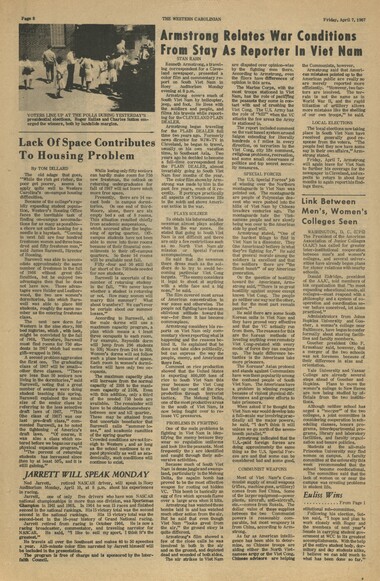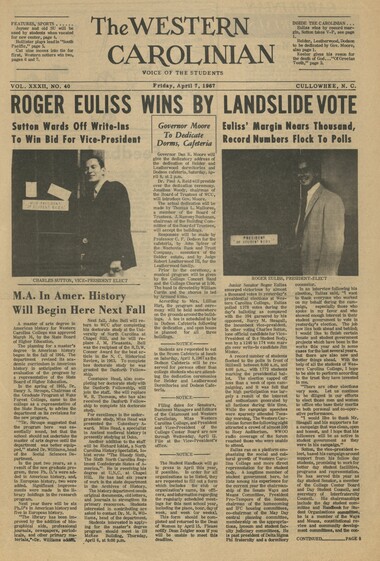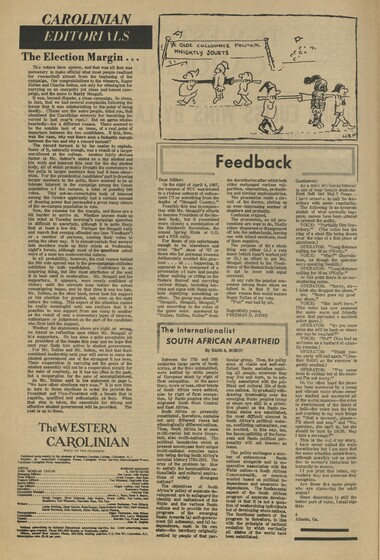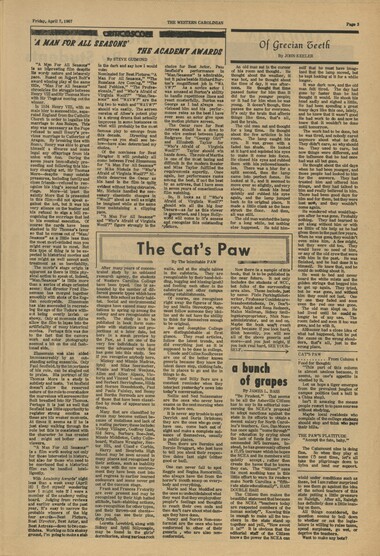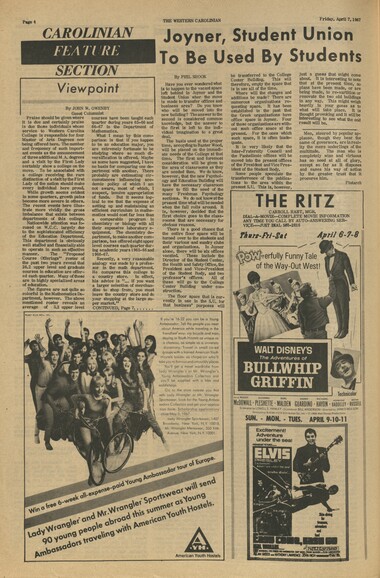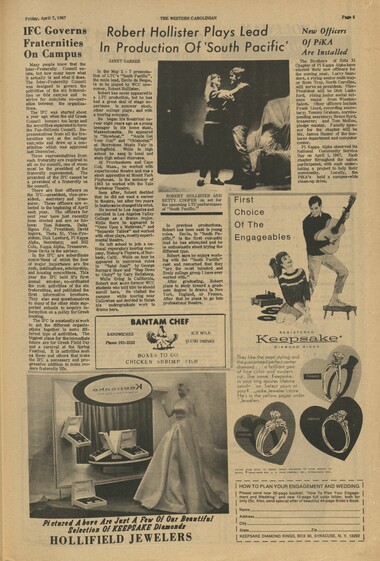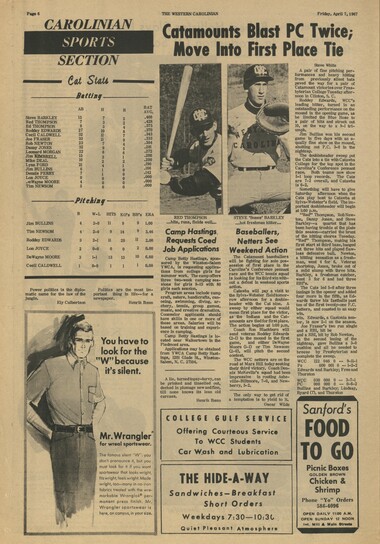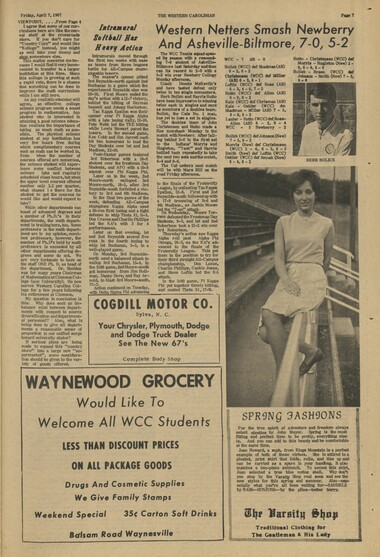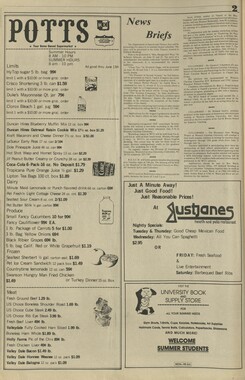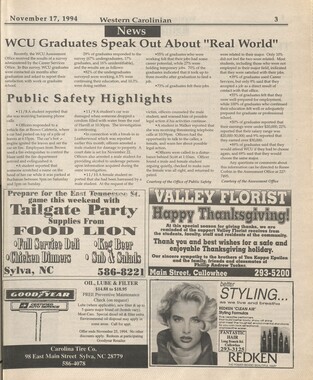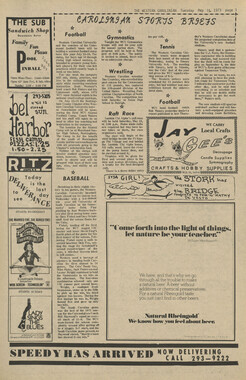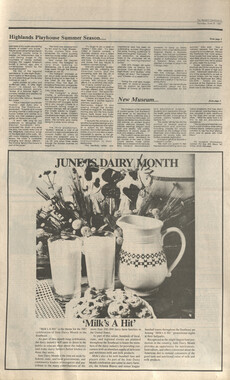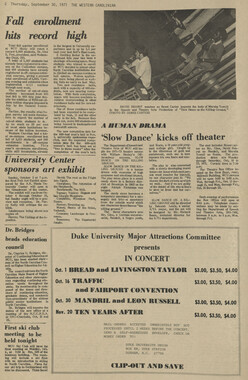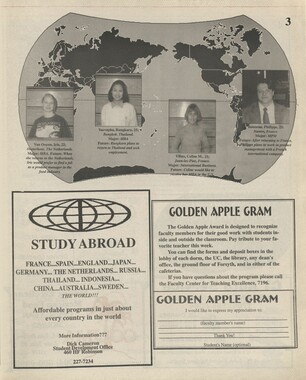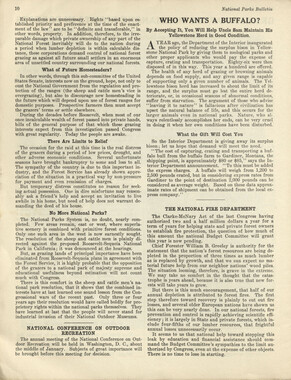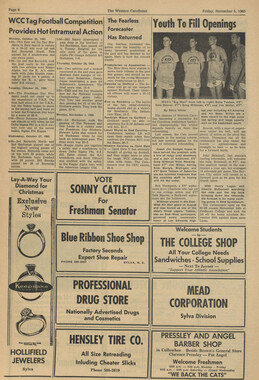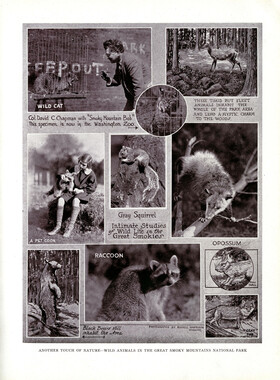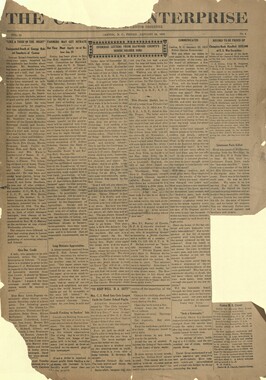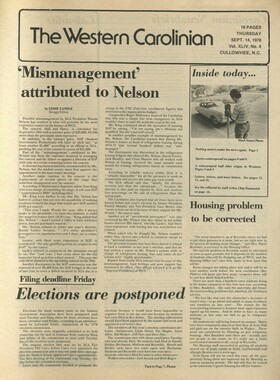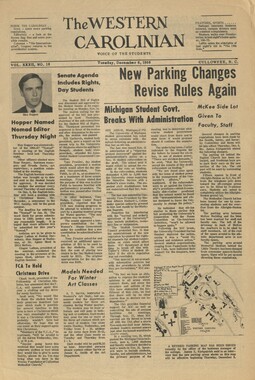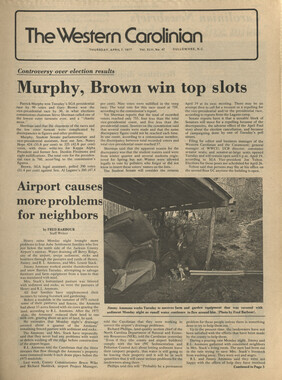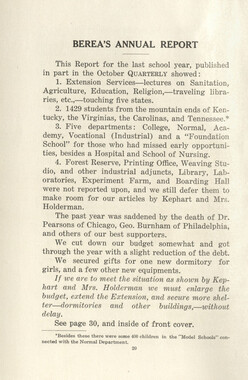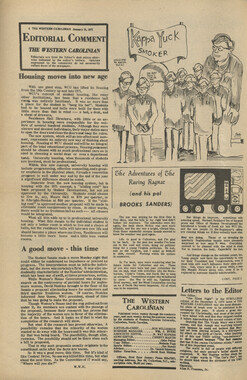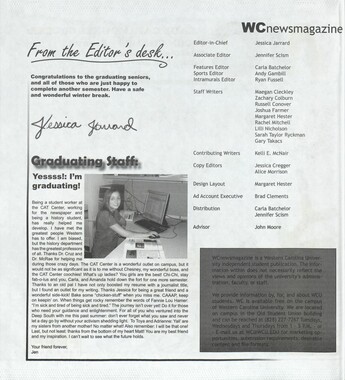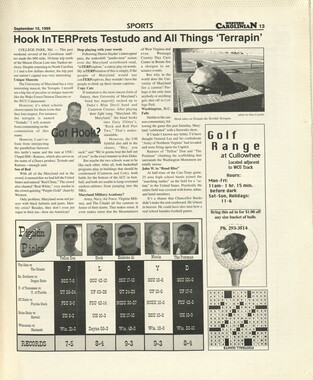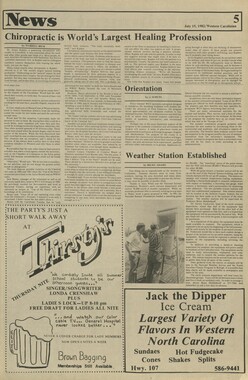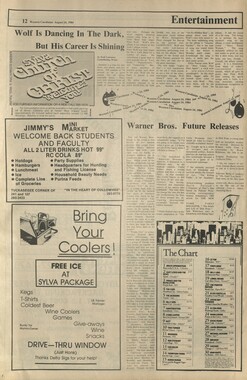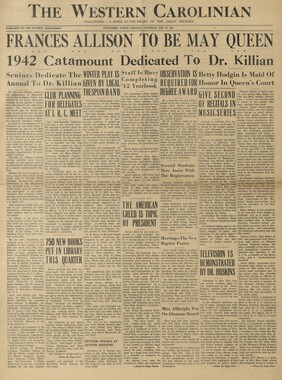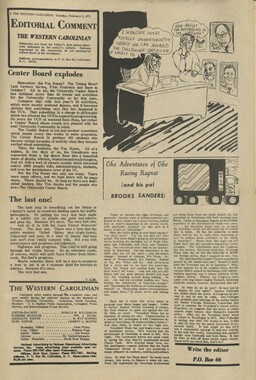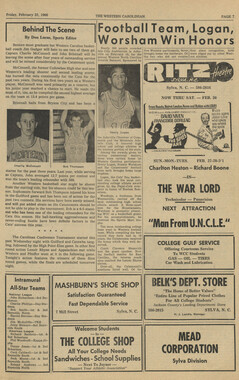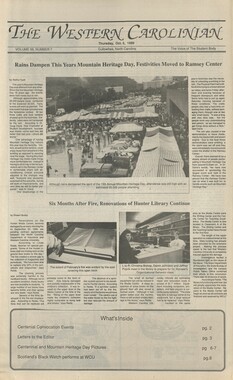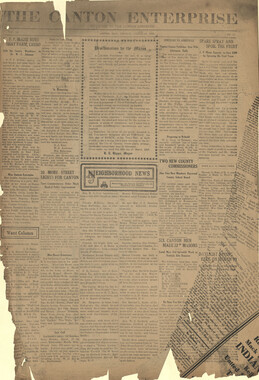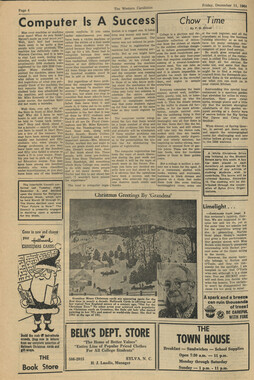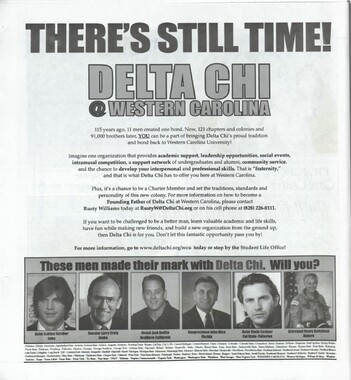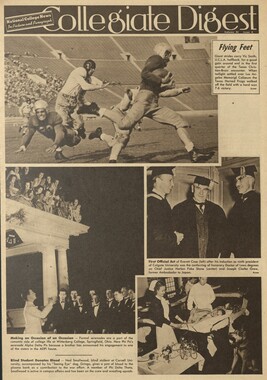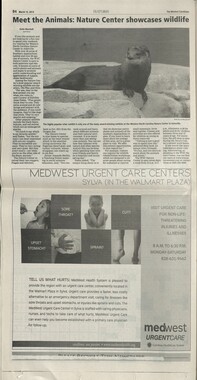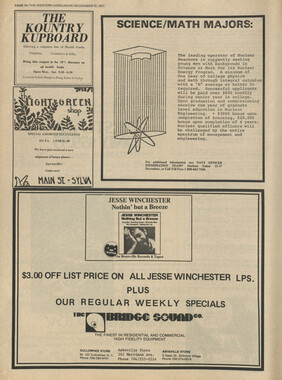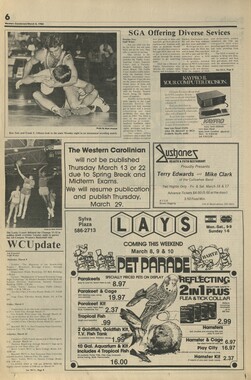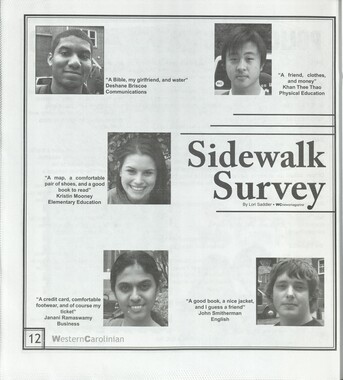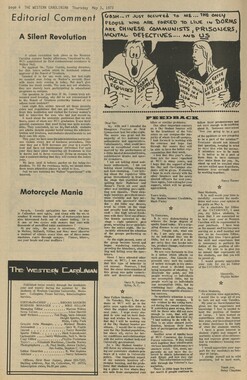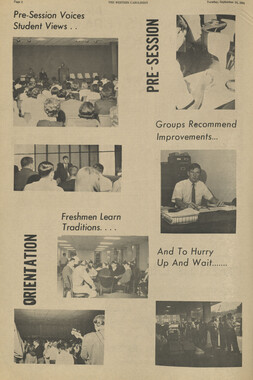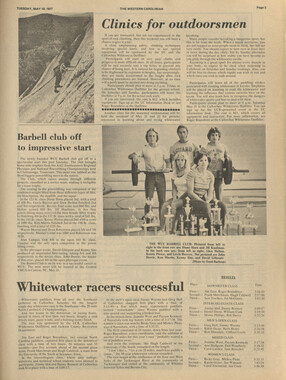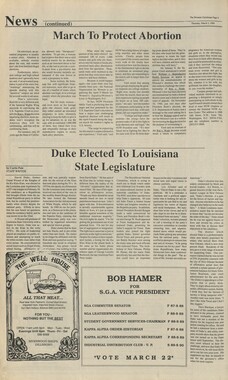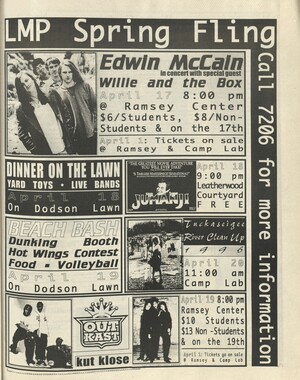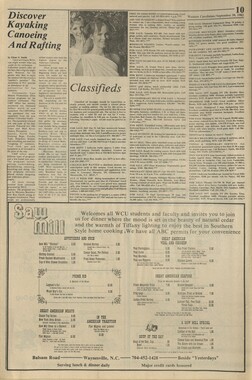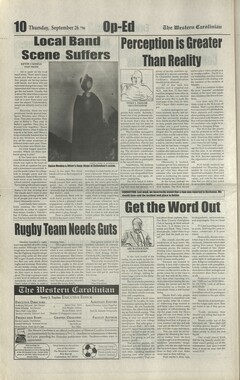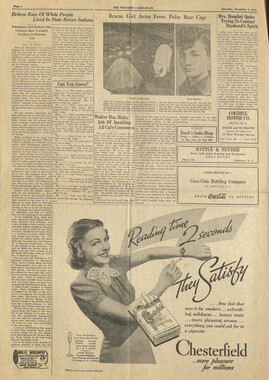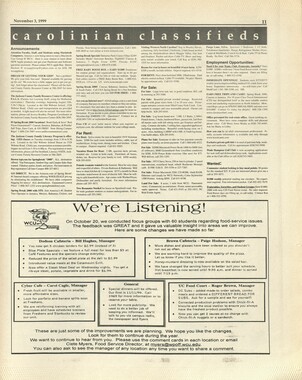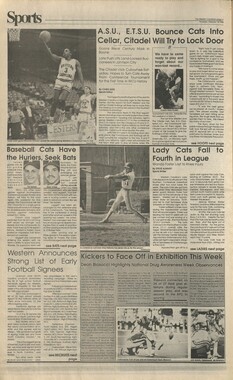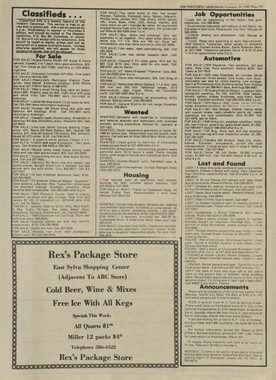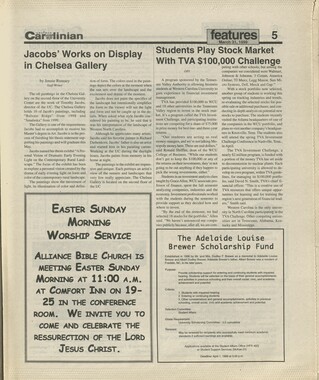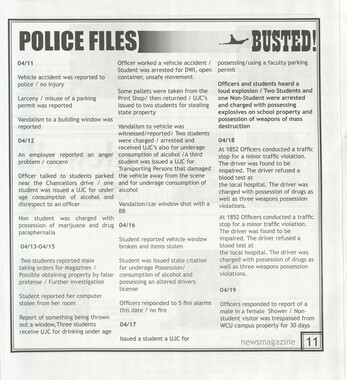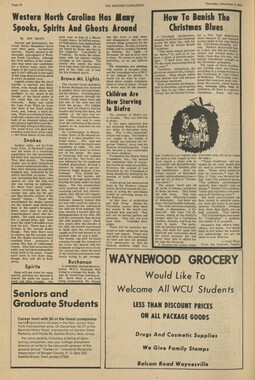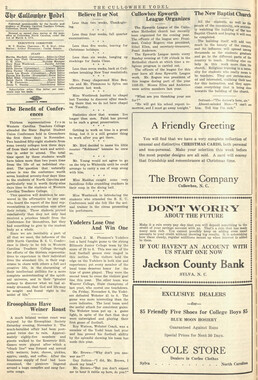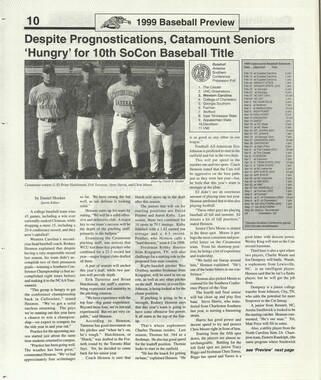Western Carolina University (20)
View all
- Canton Champion Fibre Company (2308)
- Cherokee Traditions (291)
- Civil War in Southern Appalachia (165)
- Craft Revival (1942)
- Great Smoky Mountains - A Park for America (2946)
- Highlights from Western Carolina University (430)
- Horace Kephart (941)
- Journeys Through Jackson (159)
- LGBTQIA+ Archive of Jackson County (85)
- Oral Histories of Western North Carolina (314)
- Picturing Appalachia (6873)
- Stories of Mountain Folk (413)
- Travel Western North Carolina (160)
- Western Carolina University Fine Art Museum Vitreograph Collection (129)
- Western Carolina University Herbarium (92)
- Western Carolina University: Making Memories (738)
- Western Carolina University Publications (2491)
- Western Carolina University Restricted Electronic Theses and Dissertations (146)
- Western North Carolina Regional Maps (71)
- World War II in Southern Appalachia (131)
University of North Carolina Asheville (6)
View all
- Allanstand Cottage Industries (62)
- Appalachian National Park Association (53)
- Bennett, Kelly, 1890-1974 (1463)
- Berry, Walter (76)
- Brasstown Carvers (40)
- Carver, George Washington, 1864?-1943 (26)
- Cathey, Joseph, 1803-1874 (1)
- Champion Fibre Company (233)
- Champion Paper and Fibre Company (297)
- Cherokee Indian Fair Association (16)
- Cherokee Language Program (22)
- Crowe, Amanda (40)
- Edmonston, Thomas Benton, 1842-1907 (7)
- Ensley, A. L. (Abraham Lincoln), 1865-1948 (275)
- Fromer, Irving Rhodes, 1913-1994 (70)
- George Butz (BFS 1907) (46)
- Goodrich, Frances Louisa (120)
- Grant, George Alexander, 1891-1964 (96)
- Heard, Marian Gladys (60)
- Kephart, Calvin, 1883-1969 (15)
- Kephart, Horace, 1862-1931 (313)
- Kephart, Laura, 1862-1954 (39)
- Laney, Gideon Thomas, 1889-1976 (439)
- Masa, George, 1881-1933 (61)
- McElhinney, William Julian, 1896-1953 (44)
- Niggli, Josephina, 1910-1983 (10)
- North Carolina Park Commission (105)
- Osborne, Kezia Stradley (9)
- Owens, Samuel Robert, 1918-1995 (11)
- Penland Weavers and Potters (36)
- Roberts, Vivienne (15)
- Roth, Albert, 1890-1974 (142)
- Schenck, Carl Alwin, 1868-1955 (1)
- Sherrill's Photography Studio (2565)
- Southern Highland Handicraft Guild (127)
- Southern Highlanders, Inc. (71)
- Stalcup, Jesse Bryson (46)
- Stearns, I. K. (213)
- Thompson, James Edward, 1880-1976 (226)
- United States. Indian Arts and Crafts Board (130)
- USFS (683)
- Vance, Zebulon Baird, 1830-1894 (1)
- Weaver, Zebulon, 1872-1948 (58)
- Western Carolina College (230)
- Western Carolina Teachers College (282)
- Western Carolina University (2008)
- Western Carolina University. Mountain Heritage Center (18)
- Whitman, Walt, 1819-1892 (10)
- Wilburn, Hiram Coleman, 1880-1967 (73)
- Williams, Isadora (3)
- Cain, Doreyl Ammons (0)
- Crittenden, Lorraine (0)
- Rhodes, Judy (0)
- Smith, Edward Clark (0)
- Appalachian Region, Southern (2569)
- Asheville (N.C.) (1923)
- Avery County (N.C.) (26)
- Blount County (Tenn.) (195)
- Buncombe County (N.C.) (1672)
- Cherokee County (N.C.) (283)
- Clay County (N.C.) (555)
- Graham County (N.C.) (236)
- Great Smoky Mountains National Park (N.C. and Tenn.) (519)
- Haywood County (N.C.) (3569)
- Henderson County (N.C.) (70)
- Jackson County (N.C.) (4912)
- Knox County (Tenn.) (35)
- Knoxville (Tenn.) (13)
- Lake Santeetlah (N.C.) (10)
- Macon County (N.C.) (420)
- Madison County (N.C.) (215)
- McDowell County (N.C.) (39)
- Mitchell County (N.C.) (132)
- Polk County (N.C.) (35)
- Qualla Boundary (982)
- Rutherford County (N.C.) (76)
- Swain County (N.C.) (2182)
- Transylvania County (N.C.) (270)
- Watauga County (N.C.) (12)
- Waynesville (N.C.) (86)
- Yancey County (N.C.) (72)
- Aerial Photographs (3)
- Aerial Views (60)
- Albums (books) (4)
- Articles (1)
- Artifacts (object Genre) (228)
- Bibliographies (1)
- Biography (general Genre) (2)
- Cards (information Artifacts) (38)
- Clippings (information Artifacts) (191)
- Copybooks (instructional Materials) (3)
- Crafts (art Genres) (622)
- Depictions (visual Works) (21)
- Design Drawings (1)
- Drawings (visual Works) (185)
- Envelopes (73)
- Exhibitions (events) (1)
- Facsimiles (reproductions) (1)
- Fiction (general Genre) (4)
- Financial Records (12)
- Fliers (printed Matter) (67)
- Glass Plate Negatives (381)
- Guidebooks (2)
- Internegatives (10)
- Interviews (815)
- Land Surveys (102)
- Letters (correspondence) (1013)
- Manuscripts (documents) (618)
- Maps (documents) (177)
- Memorandums (25)
- Minutes (administrative Records) (59)
- Negatives (photographs) (6090)
- Newsletters (1290)
- Newspapers (2)
- Notebooks (8)
- Occupation Currency (1)
- Paintings (visual Works) (1)
- Pen And Ink Drawings (1)
- Periodicals (193)
- Personal Narratives (10)
- Photographs (12976)
- Plans (maps) (1)
- Poetry (5)
- Portraits (4568)
- Postcards (329)
- Programs (documents) (181)
- Publications (documents) (2443)
- Questionnaires (65)
- Relief Prints (26)
- Sayings (literary Genre) (1)
- Scrapbooks (282)
- Sheet Music (2)
- Slides (photographs) (402)
- Songs (musical Compositions) (2)
- Sound Recordings (796)
- Specimens (92)
- Speeches (documents) (18)
- Tintypes (photographs) (8)
- Transcripts (322)
- Video Recordings (physical Artifacts) (23)
- Text Messages (0)
- A.L. Ensley Collection (275)
- Appalachian Industrial School Records (7)
- Appalachian National Park Association Records (336)
- Axley-Meroney Collection (2)
- Bayard Wootten Photograph Collection (20)
- Bethel Rural Community Organization Collection (7)
- Blumer Collection (5)
- C.W. Slagle Collection (20)
- Canton Area Historical Museum (2110)
- Carlos C. Campbell Collection (462)
- Cataloochee History Project (64)
- Cherokee Studies Collection (4)
- Daisy Dame Photograph Album (5)
- Daniel Boone VI Collection (1)
- Doris Ulmann Photograph Collection (112)
- Elizabeth H. Lasley Collection (1)
- Elizabeth Woolworth Szold Fleharty Collection (4)
- Frank Fry Collection (95)
- George Masa Collection (173)
- Gideon Laney Collection (452)
- Hazel Scarborough Collection (2)
- Hiram C. Wilburn Papers (28)
- Historic Photographs Collection (236)
- Horace Kephart Collection (861)
- Humbard Collection (33)
- Hunter and Weaver Families Collection (1)
- I. D. Blumenthal Collection (4)
- Isadora Williams Collection (4)
- Jesse Bryson Stalcup Collection (47)
- Jim Thompson Collection (224)
- John B. Battle Collection (7)
- John C. Campbell Folk School Records (80)
- John Parris Collection (6)
- Judaculla Rock project (2)
- Kelly Bennett Collection (1482)
- Love Family Papers (11)
- Major Wiley Parris Civil War Letters (3)
- Map Collection (12)
- McFee-Misemer Civil War Letters (34)
- Mountain Heritage Center Collection (4)
- Norburn - Robertson - Thomson Families Collection (44)
- Pauline Hood Collection (7)
- Pre-Guild Collection (2)
- Qualla Arts and Crafts Mutual Collection (12)
- R.A. Romanes Collection (681)
- Rosser H. Taylor Collection (1)
- Samuel Robert Owens Collection (94)
- Sara Madison Collection (144)
- Sherrill Studio Photo Collection (2558)
- Smoky Mountains Hiking Club Collection (616)
- Stories of Mountain Folk - Radio Programs (374)
- The Reporter, Western Carolina University (510)
- Venoy and Elizabeth Reed Collection (16)
- WCU Gender and Sexuality Oral History Project (32)
- WCU Mountain Heritage Center Oral Histories (25)
- WCU Oral History Collection - Mountain People, Mountain Lives (71)
- WCU Students Newspapers Collection (1923)
- Western North Carolina Tomorrow Black Oral History Project (69)
- William Williams Stringfield Collection (2)
- Zebulon Weaver Collection (109)
- African Americans (390)
- Appalachian Trail (35)
- Artisans (521)
- Cherokee art (84)
- Cherokee artists -- North Carolina (10)
- Cherokee language (21)
- Cherokee pottery (101)
- Cherokee women (208)
- Church buildings (189)
- Civilian Conservation Corps (U.S.) (111)
- College student newspapers and periodicals (2012)
- Dams (107)
- Dance (1023)
- Education (222)
- Floods (61)
- Folk music (1015)
- Forced removal, 1813-1903 (2)
- Forest conservation (220)
- Forests and forestry (1184)
- Gender nonconformity (4)
- Great Smoky Mountains National Park (N.C. and Tenn.) (181)
- Hunting (45)
- Landscape photography (25)
- Logging (119)
- Maps (83)
- Mines and mineral resources (8)
- North Carolina -- Maps (18)
- Paper industry (38)
- Postcards (255)
- Pottery (135)
- Railroad trains (72)
- Rural electrification -- North Carolina, Western (3)
- School integration -- Southern States (2)
- Segregation -- North Carolina, Western (5)
- Slavery (5)
- Sports (452)
- Storytelling (243)
- Waterfalls -- Great Smoky Mountains (N.C. and Tenn.) (66)
- Weaving -- Appalachian Region, Southern (280)
- Wood-carving -- Appalachian Region, Southern (328)
- World War, 1939-1945 (173)
Western Carolinian Volume 32 Number 40
Item
Item’s are ‘child’ level descriptions to ‘parent’ objects, (e.g. one page of a whole book).
-
-
Page 8 THE WESTERN CAROLINIAN Friday, April 7,1967 Armstrong Relates War Conditions From Stay As Reporter In Viet Nam VOTERS LINE UP AT THE POLLS DURING YESTERDAY'S presidential elections. Roger Euliss and Charles Sutton emerged the winners, both by landslide margins. Lack Of Space Contributes To Housing Problem By TOM DILLARD The old adage that goes, "While the rich get richer, the poor get poorer, seems to apply quite well to Western Carolina's on-campus housing difficulties. Because of the college's rapidly expanding student population, Western's Housing Office faces the inevitable task of finding on-campus accomada= tions for as many as possible— a chore not unlike looking for a needle in a haystack. "Coming in next fall are four hundred freshmen women and three hundred and fifty freshmen men," said James Barnwell, Director of Housing. Barnwell was able to accomodate approximately the same number of freshmen in the fall of 1966 without great difficulties, but he enjoyed two advantages then that he does not have now. Those advan= tages were Helder and Leather- wood, the two new women's dormitories, into which Barn- weU was able to place 800 students, roughly the same number as the entering freshman class. The next new dorm for Western is the nine story, 800 bed highrise, which , with luck, might be comvleted by the fall of 1968. Therefore, Barnwell must find rooms for 750 students in 1967 which had come gift-wrapped in 1966. A second problem aggravates the first one. The graduating class of 1967 will be small- other three classes. "There are less than 50 seniors now living in the dormitories," said BarnweU, noting that a great number of seniors were doing student teaching this spring. BarnweU explained the small size of the senior class by referring to the less selective draft laws of 1967. "This (the class of 1967) was our last pre-draft class," commented BarnweU, as he noted the tightening of America's draft laws. "Of course, it was also a class which entered before we began our rapid physical expansion program." "The percent of returning students has increased since then by at least 50%, and it is still gaining." While losing only fifty seniors can hardly make room for 750 new freshman, the outlook on returning undergraduates for fall of 1967 will not leave mkch more free space. Presently, there are 54 vacant beds in campus dormt- tories. On one end of third= Moore, alone, there are six empty bed s out of 8 rooms. This situation resulted chiefly from academic suspensions, which accrued after the beginning of spring quarter. Off- campus students have not been able to move into these rooms because of their financial commitments to their off-campus quarters. So these 54 rooms will be available next fall. Fifty =four and 50 still fall far short of the 750 beds needed for new students. Barnwell Is uncertain of the number of returning studeny in the fall. "We never know whether a student is returning or not. How many women will marry this summer? What about transfers? We can'tever be certain about our summer losses." According to BarnweU, all the male dorms will use a maximum capacity program, a plan which means a t least three occupants to each room. For example, Reynolds dorm wiU jump from 296 students to 331; Moore from 244 to 300. Women's dorms will not foUow such a plane because of space. Each room In women's dormitories will have only two occupants. The maximum capacity plan wIU increase from the normal capacity of 2168 to the maximum capacity of 2338. Even with this addition, only a third of the needed 750 beds are available. The remainder will have to be obtainefsomewhere between now and kll quarter. These may be attained from that uncertain benefactor that Barnwell caUs "summer loses," and academic casulties of the spring quarter Crowded conditions arenotfor- eigh to Western , and as long as the school continues to ex pand physically as weU as academically, such conditions will continue to exist. JARRETT WILL SPEAK MONDAY Ned Jarrett, retired NASCAR driver, will speak in Hoey Auditorium Monday, April 10, at 8 p.m. about his experiences in racing. Jarrett, one of only five drivers who have won NASCAR national championships in more than one division, was Sportsman Champion in 1961 and 1965. In 1964 he won 15 races and finished second in the national rankings. His 15 victory total was the second second in the national rankings. His 15 victory total was the second-best in the 16-year history of Grand National racing. Jarrett retired from racing in October 1966. He is now a racing broadcaster, commentator, and traveling narrator for NASCAR. He said, "I like to seU my sport. I think It's the greatest," He travels all over the Southeast and makes 40 to 50 speeches a year. A20-minute color film narrated by Jarrett himself wiU be included in the presentation. The program is free of charge and is sponsored by the Inter- faith CouncU. STANRAHN Kenneth Armstrong, a traveling correspondent for a Cleveland newspaper, presented a color film and commentary report on South Viet Nam in Hoey Auditorium Monday evening at 8 p.m. Armstrong covers much of South Viet Nam by helicopter, jeep, and foot. He lives with the soldiers and people, and films his travels while report- ing for the CLEVELAND PLAIN DEALER. Armstrong began traveling for the PLAIN DEALER full time two years ago. Formerly news director for WJW-TV in Cleveland, he began to travel, usually on his own vacation time, to Southeast Asia. Two years ago he decided to become a full-time correspondent for the PLAIN DEALER, almost invariably going to South Viet Nam four months of the year. The color fUm shown by Armstrong was made by him in the past few years, much of it re= cently. It portrays practically all aspects of Vietnamese life in the sokth and shows Ameri= can action in the war. PLAYS SOLDIER To obtain his information, the newsman almost plays soldier when in the war zones. He stated that going to South Viet Nam is not difficult and there are only a few restrictions such as no North Viet Nam air mission or Special Forces accompaniment. He said that the newsmen there dress much as the sol= diers do to try to avoid becoming particular Viet Cong targets. "The enemy considers it legal to shoot at anything with a white face and a big nose," he said. The film covered most areas of American concentration in war zones and otherwise The people not fighting have taken an oblivious attitude toward the war—for them it has become commonplace. Armstrong considers his reports on Viet Nam only commentary views reporting what is happening and the reasons behind it, He explained that he does not take sides politically, but can express the way the people, enemy, and Americans there feel. Comment on rice production showed that the United States is exporting 800,000 tons of rice to South Viet Nam this year because the Viet Cong has tied up most of the rice production through terrorist tactics. The Mekong Delta, one ofthemostproductiveareas in the south of Viet Nam, is now being fought over to release VC pressures. PROBLEMS IN FIGHTING One of the main problems in fighting in Viet Nam is identifying the enemy because they wear no regulation uniforms and look like the peasants. Most frequently the y are identified and caught through their subversive activities. Because much of South Viet Nam is dense jungle and swampland, particularly in the Mekong Delta, the napalm bomb has proved to be the most effective weapon for routing out hidden VC. This bomb is basicaUy an egg of fire which spreads flame over a large area when it hits. Armstrong has watched these bombs laid in and has watched much other action from the air. But he said that even though Viet Nam "looks great from the air," the ground story is quite different Armstrong's fUm showed a few of the close calls he was involved in both in the air and on the ground, and depicted dead and wounded of both sides. The air strikes in Viet Nam are disputed over opinion-wise by the fighting men there. According to Armstrong, even the fliers have differences of opinion in this area. The Marine Corps, with the most troops stationed In Viet Nam, has the role of pacifying the peasants they come in contact with and of crushing the Viet Cong. The U.S. Army has the role of "kUl" when the VC attacks the few areas the Army is stationed in. The report included comment on the vast tunnel system around Saigon extending for literally hundreds o f miles in every direction, on terrorism by the Viet Cong, city life comment, religious problems, recreation, and some small observance of politics and top secret security measures. SPECIAL FORCES The U.S. Special Forces' job of winning over the Northern montagnards in Viet Nam was pointed out The montagnards are people of Polynesian descent who were pushed into the hUls of Viet Nam by Chinese invaders centuries ago. The montagnards hate the Vietnamese people and are slowly being won over to the American side by good will. Armstrong stated, "One of the hardest things to find in Viet Nam is a dissenter. They (the Americans) believe in what they're fighting for." He said that general morale among the soldiers is excellent and that the soldiers there are "the finest bunch" of any American generation. On the question of hostility toward the Americans, Armstrong said, "There is no great hostility against anyone except known Viet Cong. The people go neither one way nor the other, but for the most part remain passive." He said there are some South Korean units in Viet Nam and they have proved very effective and that the VC actually run from them. The reasons for this are the Korean methods of leveling anything even remotely Viet Cong-related with every mode of force they can conjure up. The basic difference be- tactics is the Americans take more prisoners. The Koreans' Asian protocol and stands against Communism have won them popularity among the confused people of South Viet Nam. The Americans have a problem in winning respect because of violent physical differences and greater efforts to take prisoners. When asked if he thought the Viet Nam war would develop into a full-scale war involving practically all the major powers, he said, "I dont think it will unless we go north of the seventeenth parallel." Armstrong indicated that the U.S.-paid foreign forces are doing approximately the same thing as the U.S. Special Forces are and that some can be considered bad and some good. COMMUNIST WEAPONS Most of Viet Nam's Communist supply of small weapons (rifles, machine guns, artillery) comes from Red China. Some of the larger equipment—power plants, aircraft, anti-aircraft, etc.—comes from Russia. The dollar value of these supplies between the two Communist powers is reasonably comparable, but most weaponry is from China, according to Armstrong. As far as American inteUi- gence has been able to determine, no Chinese troops are aiding either the North Vietnamese army or the Viet Cong. Chinese advisors are helping the Communists, however, Armstrong said that American mistakes pointed up to the American public are really no are merely reported more efficiently. "However, two factors are involved. The terrain is not the same as in World War II, and the rapid tilization of artillery allows more mistakes like the shelling of our own troops," he said. LOCAL ELECTIONS The local elections now taking place in South Viet Nam have received generally good response from the voters. "The people feel they now have some say In their own affairs," Armstrong stated. Friday, April 7, Armstrong will again leave for Viet Nam to further his coverage for the newspaper in Cleveland, and expects to return in about four months to again report his findings there. Link Between Men's, Women's Colleges Seen WASHINGTON, D. C. (CPS) The President of the American Association of Junior Colleges (AAJC) has caUed for greater inter-institutional cooperation between men's and women's colleges, and several universities have already begun plans for closer relations with nearby schools. Donald Eldridge, president of the AAJC, told members of his organization that "to meet expanding educational needs, all colleges—must respond with a philosophy and a system of cooperation and coordination never before conceived, let alone practiced." Administrators from Johns Hopkins University and Gou- cher, a woman's coUege near Baltimore, have begun to confer formally about sharing faciU- ties and faculty members. Goucher president Otto F. Kraushaar said, however, that a merger of the two schools was not foreseen because of their difference in size and orientation. Yale University and Vassar College are already several steps ahead of Goucher and Hopkins. Plans to move the women's college to New Haven are now being studied by officials from the two institutions. Although neither school has urged a "merger" of the two colleges, a joint committee is considering cooperation in scheduling classes, honors programs, interdepartmental programs, library and laboratory facUities, and faculty organization and tenure policies. Students at the all-male Princeton University may find women on campus. A faculty committee at the university this week recommended that the school become coeducational. The committee said that the lack of women on or near the campus was creating problems in student life. Euliss Wins From Page 1 stitutional sub-committee. Following his election, Sutton said, "I hope and plan to work closely with Roger and the members of next year's Senate in carrying student government at WCC to its greatest accomplishments. With the help pf the entire student body, dormitory and day students alike, I believe we can add much to what has been done so far."
Object
Object’s are ‘parent’ level descriptions to ‘children’ items, (e.g. a book with pages).
-
The Western Carolinian is Western Carolina University’s student-run newspaper. The paper was published as the Cullowhee Yodel from 1924 to 1931 before changing its name to The Western Carolinian in 1933.
-
